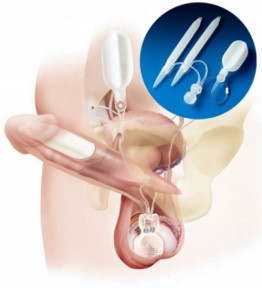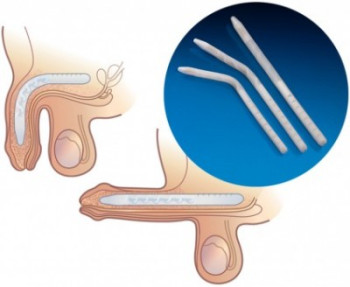Penile Prosthesis
The most commonly used penile prosthesis are the "three-component" or "hydraulic" ones. Two cylinders are placed inside the penis, which, while the prosthesis is deactivated, are empty, but can be filled by squeezing the pump that was placed in the scrotum. Hydraulic prosthesis allow an erection with maximum rigidity and are very discreet when they are deactivated. By being able to activate and deactivate them at our will and without risk of failure, it returns the spontaneity and confidence to our sexual relations.
Erectile dysfunction or impotence is a disease that has a global prevalence of 52% in men aged 40 to 70 years. Being the complete erectile dysfunction (severe) 9.6% being present in one of every two consultations on sexuality attended by family doctors.
The treatment usually uses drugs for the erection, such as sildenafil, vardenafil and tadalafil. However, 15% of men do NOT respond to medication. For them, the best option is the penile prosthesis implant.
There is another type of prosthesis (malleable or semi-rigid) which are also placed inside the penis, the most important difference (apart from the cost) is that they are rigid all the time but have a certain degree of mobility to be able to direct them towards where the patient most suits him at that time. They are much cheaper and are still an acceptable option in certain cases.
HOW ARE THESE PROSTHESES PLACED?
 |
 |
The implant of the prosthesis is performed through surgery through an incision in the scrotum. The postoperative period lasts between 24 and 48 hours and after 6 weeks you can resume sexual relations. After the surgery there are usually no visible scars, even if you are naked you can not know if we have an implanted prosthesis (hydraulic).
The sensitivity, the ability to orgasm and the ejaculation are not altered at all. With the penile prosthesis the rigidity of the penis is recovered, thus normalizing sexual relations.
DOES THE IMPLANT NEED ANY SPECIAL CARE AFTER PLACEMENT?
The implant does not need maintenance, the half-life of a penile prosthesis is 10 years after its placement. Commercial houses guarantee the device for life.
CAN ANY UROLOGIST PLACE IT?
Definitely to be such a specialized procedure it is necessary to thoroughly investigate the credentials of the urologist who is offering this procedure. We suggest someone who has had some additional training in concentration centers and with international recognition to ensure proper placement.
Dr. Javier A. López had the opportunity to be in 2 international centers both in the city of Madrid in the Reconstructive / Andrology service and in the city of Belgrade with Dr. Rados Djinovic, world leader in prosthetic surgery.
PEYRONIE´S DISEASE
Peyronie's disease is a curvature of the penis due to the appearance of a fibrous-inflammatory zone that causes retraction of the corpus cavernosum. In most cases the cause of Peyronie's disease is unknown. It is much more frequent than you think, affects at least 5 to 9% of men over 50 years
In patients with Peyronie's disease with a severe curvature and erectile dysfunction, the removal of the plaque and a penile prosthesis implant should be performed, with this we can correct the problem without any inconvenience even to gain some length of the penis



